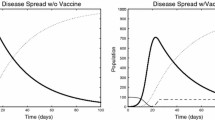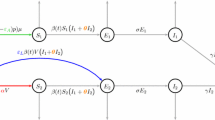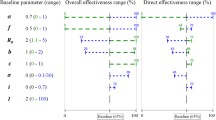Abstract
Despite the effectiveness of vaccines in dramatically decreasing the number of new infectious cases and severity of illnesses, imperfect vaccines may not completely prevent infection. This is because the immunity afforded by these vaccines is not complete and may wane with time, leading to resurgence and epidemic outbreaks notwithstanding high levels of primary vaccination. To prevent an endemic spread of disease, and achieve eradication, several countries have introduced booster vaccination programs. The question of whether this strategy could eventually provide the conditions for global eradication is addressed here by developing a seasonally-forced mathematical model. The analysis of the model provides the threshold condition for disease control in terms of four major parameters: coverage of the primary vaccine; efficacy of the vaccine; waning rate; and the rate of booster administration. The results show that if the vaccine provides only temporary immunity, then the infection typically cannot be eradicated by a single vaccination episode. Furthermore, having a booster program does not necessarily guarantee the control of a disease, though the level of epidemicity may be reduced. In addition, these findings strongly suggest that the high coverage of primary vaccination remains crucial to the success of a booster strategy. Simulations using estimated parameters for measles illustrate model predictions.
Similar content being viewed by others
References
Anderson, R.M., Grenfell, B.T.: Quantitative investigations of different vaccination policies for the control of congentila rubella syndrome (CRS) in the United Kingdom. J. Hyg. Camb. 96, 305–333 (1986)
Anderson, R.M., May, R.M.: Infectious Diseases of Humans. Oxford Univ. Press, London/New York, 1991
Behrman, R.E., Kliegman, R.M.: Nelson Essentials of Paediatrics. Saunders, 1998
Breban, R., Blower, S., Geffen, D.: Letter to the Editor: The reinfection threshold does not exist. J. Theor. Biol. 235, 151–152 (2005)
Bolker, B.M.: Chaos and complexity in measles models: a comparative numerical study. IMA J. Math. Appl. Med. Biol. 10, 83–95 (1993)
Böttiger, M., Forsgren, M.: Twenty years' experience of rubbela vaccination in Sweden: 10 years of selective vaccination (of 12-year-old girls and of women postpartum) and 13 years of a general two-dose vaccination. Vaccine 15, 1538–1544 (1997)
Chen, R.T., Markowitz, L.E., Albrecht, P.: Measles antibodies: re-evaluation of protective titres. J. Infect. Dis. 162, 1036–1062 (1990)
de Francisco, A., Hall, A.J., Unicomb, L., Chakraborty, J., Yunus, M., Sack, R.B.: Maternal measles antibody decay in rural Bangladeshi infants–implications for vaccination schedules. Vaccine 16, 564–568 (1998)
Dietz, K.: The evaluation of rubella vaccination strategies. The Mathematical Theory of the Dynamics of Biological population II. (Academic Press, NY, NY 1981) 81–98
Davidkin, I., Valle, M.: Vaccine-induced measles virus antibodies after two doses of combined measles, mumps and rubella vaccine: a 12-year follow-up in two cohorts. Vaccine 16, 2052–2057 (1998)
Earn, D.J.D., Rohani, P., Bolker, B.M., Grenfell, B.T.: A simple model for complex dynamical transitions in epidemics. Science 287, 667–670 (2000)
Fenner, F., Henderson, D.A., Arita, I., Jezek, Z., Ladnyi, I.D.: Smallpox and its eradication. WHO, 1998
Garly, M.A., Aaby, P.: The challenge of improving the efficacy of measles vaccine. Acta Tropica 85, 1–17 (2003)
Gomes, M.G.M., White, L.J., Medley, G.F.: Infection, reinfection, and vaccination under suboptimal immune protection: epidemiological perspectives. J. Theor. Biol. 228, 539–549 (2004)
Gomes, M.G.M., White, L.J., Medley, G.F.: The reinfection threshold. J. Theor. Biol. 236, 111–113 (2005)
Gustavson, T.L., Lievens, A.W., Brunell, P.A.: Measles outbreak in a fully immunized secondary school population. 316, 771–774 (1987)
Galazka, A.M., Robertson, S.E., Oblapenko, G.P.: Resurgence of diphteria. Eur. J. Epidemiol. 11, 95–105 (1995)
Gay, N.J., Pelletier, L., Duclos, P.: Modelling the incidence of measles in Canada: an assessment of the options for vaccination policy. Vaccine 16, 794–801 (1998)
Guckenheimer, J., Holmes, P.: Nonlinear Oscillations, Dynamical Systems, and Bifurcations of Vector Fields, AMS 42, Springer-Verlag, New York, Inc. 1983
Henao-Restrepo, A-M., Strebel, P., Hoekstra, E.J., Birmingham, M., Bilous, J.: Experience in global measles control, 1990–2000. J. Infec. Dis. 187, S15-21 (2003)
Hethcote, H.W.: The mathematics of infectious diseases. SIAM Rev. 42 (4), 599–653 (2000)
Janaszek, W., Gay, N.J., Gut, W.: Measles vaccine efficacy during an epidemic in 1998 in the highly vaccinated population in Poland. Vaccine 21, 473–478 (2003)
Janaszek, W., Slusarczyk, J.: Immunity against measles in population of women and infants in Poland. Vaccine 21, 2948–2953 (2003)
Katzmann, W., Dietz, K.: Evaluation of age-specific vaccination strategies. Theor. Pop. Biol. 25, 125–137 (1984)
Keeling, M.J., Grenfell, B.T.: Understanding the persistence of measles: reconciling theory, simulation and observation. Proc. R. Soc. Lond. B 269, 335–343 (2002)
Keeling, M.J., Rohani, P., Grenfell, B.T.: Seasonally forced disease dynamics explored as switching between attractors. Phys. D 148, 317–335 (2001)
Kribs-Zaleta, C.M., Martcheva, M.: Vaccination strategies and backward bifurcation in an age-since-infection structured model. Math. Biosci. 177, 317–332 (2002)
Kribs-Zaleta, C.M., Velasco-Hernández, J.X.: A simple vaccination model with multiple endemic states. Math. Biosci. 164, 183–201 (2000)
Lakshmikantham, V., Leela, S.: Differential and Integral Inequalities: Theory and Applications. Academic Press, New York, 1969.
Li, X-Z., Gupur, G.: Global stability of an age-structured SIRS epidemic model with vaccination. Discrete Contin. Dyn. Syst. Ser. B, 4, 643–652 (2004)
McLean, A.R., Anderson, R.M.: Measles in developing countries. Part I. Epidemiological parameters and patterns. Epidemiol. Infect. 100, 11–133 (1988)
Moghadas, S.M.: Modelling the effect of imperfect vaccines on disease epidemiology. Discrete Contin. Dyn. Syst. Ser. B, 4, 999–1012 (2004)
Moghadas, S.M., Gumel, A.B.: A mathematical study of a model for childhood diseases with non-permanent immunity. J. Comput. Appl. Math. 157, 347–363 (2003)
Mossong, J., Muller, C.P.: Modelling measles re-emergence as a result of waning of immunity in vaccinated population. Vaccine, 21, 4597–4603 (2003)
Mossong, J., Nokes, J., Edmunds, D.J., Cox, W.J., Ratman, M.J., Muller, C.P.: Modelling the impact of subclinical measles transmission in vaccinated populations with waning immunity. Am. J. Epidemiol. 150, 1238–1249 (1999)
Müller, J.: Optimal vaccination patterns in age-structured populations. SIAM J. Appl. Math. 59, 222–241 (1998)
Paulo, A.C., Gomes, M.C., Casinhas, A.C., Horta, A.: Multiple dose vaccination against childhood diseases: high coverage with the first dose remains crucial for eradication. IMA J. Math. Appl. Med. Biol. 17, 201–212 (2000)
Pelletier, L., Chung, P., Duclos, P., Manga, P., Scott, J.: A benefit-cost analysis of two-dose measles immunization in Canada. Vaccine 16, 989–996 (1998)
Piccardi, C., Lazzaris, S.: Vaccination policies for chaos reduction in childhood epidemics. IEEE Trans. Biomed. Eng. 45, 591–595 (1998)
Piyawong, W., Twizell, E.H., Gumel, A.B.: An unconditionally convergent finite-difference scheme for the SIR model. Appl. Math. Comput. 146, 611–625 (2003)
Ratnam, S., West, R., Gadag, V., Burris, J.: Measles immunization strategy: measles antibody response following MMR II vaccination of children at one year of age. Can. J. Public Health 87, 97–100 (1996)
Rohani, P., Earn, D.J.D., Finkenstädt, B., Grenfell, B.T.: Population dynamics interference among childhood diseases. Proc. R. Soc. Lond. B 265, 2033–2041 (1998)
Rohani, P., Kelling, M.J., Grenfell, B.T.: The interplay between determinism and stochasticity in childhood diseases. Am. Nat. 159, 469–481 (2002)
Rouderfer, V., Becker, N.G., Hethcote, H.W.: Waning immunity and its effect on vaccination schedules. Math. Biosci. 124, 59–82 (1994)
Shulgin, B., Stone, L., Agur, A.: Pulse vaccination strategy in the SIR epidemic model. Bull. Math. Biol. 60, 1123–1148 (1998)
Strebel, P., Cochi, S., Grabowsky, M., Bilous, J., Hersh, B.S., Okwo-Bele, J.M., Hoekstra, E., Wright, P., Katz, S.: The unfinished measles immunization agenda. J. Inf. Dis. 187, S1–S7 (2003)
Teitelbaum, M.A., Edmunds, M.: Immunization and vaccine-preventable illness, United States, 1992–1997. Stat. Bull. Metrop. Insur. Co. 80, 13–20 (1999)
Whittle, H.C., Aaby, P., Samb, B., Jensen, H., Bennet, J., Simondon, F.: Effect of subclinical infection on maintaining immunity against measles in vaccinated children in West Africa. Lancet 353, 98–102 (1999)
Williams, B.G., Cutts, F.T., Dye, C.: Measles vaccination policy. Epidemiol. Infect. 115, 603–621 (1995)
Wright, S.W.: Pertussis infection in adults. South. Med. J. 91, 702–708 (1998)
Author information
Authors and Affiliations
Corresponding author
Additional information
This work was supported in part by the Natural Sciences and Engineering Research Council of Canada (NSERC). One of the authors (P.R.) acknowledges the support of the Ellison Medical Foundation.
Rights and permissions
About this article
Cite this article
Alexander, M., Moghadas, S., Rohani, P. et al. Modelling the effect of a booster vaccination on disease epidemiology. J. Math. Biol. 52, 290–306 (2006). https://doi.org/10.1007/s00285-005-0356-0
Received:
Revised:
Published:
Issue Date:
DOI: https://doi.org/10.1007/s00285-005-0356-0




